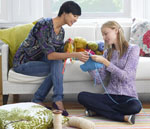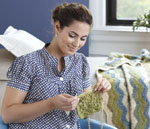Are you interested in learning a new craft, or do you know someone who is?
Starting out can be hard when you’re learning a brand new skill. We’ve all heard people talk about how hard it must be, but with these tips on getting started and a little patience, learning can be fun and simple.
 |
Watch a short video. Sometimes it’s very helpful to watch someone else’s hands working to understand how the yarn is supposed to move. You don’t have to go out and buy one either; check out our free Learn to Knit and Learn to Crochet videos for help. |
 |
Take a class. Local in-person classes or internet classes are great for people who learn well from formal instruction. If you’re in the NYC area, come by the Lion Brand Yarn Studio for a class! |
 |
Learn with a friend, or group of friends. A buddy to learn with can be a great boon to you while you’re just starting out. You can swap tips and help one another as you learn. |
 |
Find a friend who already knows how. A friend with a skill can be teacher, translator, and compassionate helper when things get confusing. If you know a proficient crafter who’s interested in teaching, let them try out their lesson plans on you. |
 |
Call customer support. When you need support on your first pattern or just aren’t sure where to find a resource you need, call us! Call our Customer Support line (877-412-9772) from 9 a.m to 5 p.m. e.s.t. from Monday to Friday, or email us at support@email.lionbrand.com |
 |
Forgive yourself! Mistakes are part of learning a new skill. When something goes awry, simply rip back (a crafting term for pulling out the stitches you’ve made) and yarn lets you try all over again. You’re learning! Go easy on yourself and you’ll pick it up in no time. |
Are you learning a new craft, or helping someone learn? What do you think are the best tips for a beginner? Leave a comment to share!
You must be <a href="https://blog.lionbrand.com/wp-login.php?redirect_to=https%3A%2F%2Fblog.lionbrand.com%2F6-tips-on-how-to-learn-to-knit-or-crochet%2F">logged in</a> to post a comment.
Lambert_carrie
I teach crocheting – and it is SO much fun with a group – love mom-daughter classes! The best advice I can give is – relax and enjoy yourself – don’t stress – your stitches will be too tight and your muscles will tighten up and can give you muscle cramps/pain. Remember – this is for your enjoyment – and for me – and many – it’s a form of therapy – and pushing yourself to be perfect or stressing over your work – which will be imperfect in the beginning as it is for everyone – this is the opposite of what sitchery is designed to be. Love your self – and be gentle with yourself and your work – and it will reflect in the beautiful things you produce.Â
GreenFuzzer
I would like to add that if you think you can/know you can you will succeed in learning. If you start off negative then you will never learn. Be the person that says “Wow that is great. It looks difficult. Can you teach me how?” and jump in. Not that person that says “Oh that is pretty. It’s too hard for me. I could never learn that.” If that is you the you are right you will never learn how and won’t have the joy the rest of us do.
Jackie Roberts
I taught my daughter-in-law how to crochet and it was a great bonding experience. I suggest taking it slow and one step at a time. After learning chain and single crochet make a 6″ square. This will give you practice before going to double crochet. We made lap throws and each square was a different stitch or technique.
The finished project was fun to look back at and see how far we’ve come.
Kristina
Start with a medium sized hook or needles and a smooth worsted weight or bigger yarn. It’s easier to see where to put your next stitch if you can clearly see the previous stitches.
Nrhaller
Not only a smooth worsted weight or bigger yarn, but also a solid color yarn too. A variegated yarn is more difficult to see the stitches well.
Sarah W.
I’m gearing up to teach a Girl Scout troop to crochet. It’s on Jan. 24, and any tips for teaching 10 girls would be great! I’ve taught a couple friends the basics, but this time I’ll only have an hour and a half to teach them. Any good beginner patterns that only use the ch, sc, and dc stitches you could send my way would be greatly appreciated!
Blue_phoenix66
I would just have them do about 6in of each stitch and make a scarf you could have them do a block of sc then dc and then start over it makes a really cute scarf , another idea would be fingerless gloves it’s basically just a rectangle and sewn on one edge this would also teach them finishing and seaming.
Sarah W.
I was also thinking about having them turn their first projects into scarves, then donate them to the homeless. We’re here in Portland OR, and we have a large homeless population. That way they could turn it into something to help the less fortunate. I’m not the troop leader, just volunteering my time and skills. As far as the fingerless gloves, I do have a nicelittle pattern that only has a few increases, but I feel like I would want to wait for a second lesson or meeting before teaching them to work in the round. Thanks for the ideas!
Umilynne
I taught a group of kids once. I had them make a square. Then we put them together as a blanket to donate to Warm Up America.
LF
Ten girls of any age is a lot to personally supervise. Find 2 or 3 volunteers that know how to crochet to help you give individual attention after you teach your lesson plan and while the girls are following your directions.
Jvmalcolm
Forget pattern when you’re learning. In essence, you’re teaching them to make a swatch! It’s a practice piece when you have 1-1/2 hours. If you have to call it something, call it a Granny square.
julie in Alabama
I taught Girl Scouts for 9 years. You didn’t mention the age of the girls, but be prepared for them to be SLOW and need LOTS of help. Some will catch one easier than others, but don’t be surprised if they don’t finish anything. If you want them to finish the project, it may have to be an ongoing lesson. I would start with chain stitches and single crochet stitches.  Anything more will just confuse the beginners. Good luck.
Sarah W.
I’m not sure of the girls ages, but I saw a few of them and they appear to be in the 9-11 range. I’m thinking about seeing if I can come back once a month to check on progress, troubleshoot, and teach new stitches or techniques. That way I don’t just shlw them something once, then not be able to provide follow-up support
Nrhaller
I am a retired elementary teacher, and taught crocheting during indoor recesses during the winter, to the BOYS as well as the GIRLS. I definitely agree with Julia in Alabama. The girls will be slow, and will need lots of repeat practice. For the first lesson teaching them to chain (ch) will be great. Many will have their tension too tight, and will need lots of repeat practice to get the tension of each chain to be consistent. As some get more consistent, then teach them how to turn and do a single crochet (sc) stitch. Also make sure you teach them the abbreviations for each stitch so when they need to read a pattern it will not be like a foreign language.
Maybe the GS troop leaders will let you come back for a half hour work session for a few weeks or months to trouble shoot and teach new stitches. Even 20 minutes would be great. I do not know if the leaders could afford to give that time to you each week, but it sure would be great for the girls.
Nrhaller
Sarah, I forgot to suggest that you teach the girls how easy and quick it is to rip out when they need to. Girls may be afraid or just leery ripping out their hard work. Explain how necessary this step is to make their projects come out beautiful.Â
Teaching the girls to turn and go back, will be a huge deal to some. Teaching 10 at the same time, will be difficult. I suggest you take one at a time, while the others are practicing their chains. (The chains can be long or kept short by having them do about 25 to 30 and then ripping it out to get more consistent chain stitches.)
kj
I recently taught myself to crochet. I discovered a few key things:
1. The most important thing is getting comfortable with tensioning the yarn. The stitches themselves are easy! Focus on making evenly-sized stitches. I practiced with I and K hooks. (I think it’s natural to over-tighten at first.)
2. Learn to chain without any twists.
3. Learn how to end the rows properly so they are straight and neat.
If you can provide them the foundation of good tension and knowing how to end the rows properly, you can send them away with confidence! HAVE FUN!
Sarah W.
I picked up 10 balls of yarn, all the same color, and size K hooks for all of them. I figured that was a good size for them to see their stitches, and I picked a good color for visibility too. Thanks to everybody for all the great tips and advice!
Czech63
Sarah are there any girls that are left handed? If so do the mirror image have them sit in front of you to see how you do it. I am left handed but learned to crochet right handed( ambidextrious). Otherwise you might like to find some one that is lefthanded and crochets.
kj
I recently taught myself to crochet. I discovered a few key things:
1. The most important thing is getting comfortable with tensioning the yarn. The stitches themselves are easy! Focus on making evenly-sized stitches. I practiced with I and K hooks. (I think it’s natural to over-tighten at first.)
2. Learn to chain without any twists.
3. Learn how to end the rows properly so they are straight and neat.
If you can provide them the foundation of good tension and knowing how to end the rows properly, you can send them away with confidence! HAVE FUN!
Patcardella2001
Try a headband. chain for the head size, then single or doublecrochet around joining the chain. Continue working in the round until desired width. They’ll love it!
Margaret
Good luck on your class today! Here are a few resources to check out if you’d like more tips:
Episode 70 of our podcast YarnCraft focuses on how to help others learn to craft:
YarnCraft Episode 70 :: Tips & Tricks on Teaching Beginner & Advanced Knitting & Crochet Skills: http://dld.bz/aHHy3
And here are two of our blog posts full of tips for teaching:
9 Secrets to Helping a Beginner Knitter or Crocheter: http://bit.ly/yLzbhx
This Season, Give the Gift of Knitting & Crocheting (5 Tips for Teaching Beginners): http://bit.ly/Adztr5
One more tip – if you’re thinking about coming back to help them with projects, consider having them store their hooks, yarn and project in a large zipper-close plastic bag. This will protect the yarn and their hard work while carrying it back and forth.
Hope these help, and we’d love to hear how the class goes!
Booclady
Count your stitches, it definitely cuts down on the rip back! Enjoy, working with fibers and colors is wonderful
Susan
One of the Christmas presents to my 8 year old granddaughter was her personal “craft bag”…just a denim bag from the craft store, with some “glow in the dark” fabric paint which she used to decorate it. I filled it with crochet hooks and knitting needles, yarn, some plastic canvas, an embroidery kit, her own craft scissors and some miscellaneous tools. It was more of a hit than the toys and we have had so much fun learning these crafts. She has already completed several projects including a garter stitch scarf which was done in time for the first day back at school! One simple hint….sit BESIDE the person you are teaching so that what they see is in the same perspective as doing it oneself.
Roloson 3
I found that working in the round was easier than working straight back and forth. when I started crocheting granny squares and different variations were a fun way to go and they bigger real quick.
Watch out for that lefty they seem to pop up in the group. If they are not old enough to figure out that everything you do is mirror image of what you tell them. You should have at least a couple helpers helping you and one should of the opposite hand.
 If that is unavoidable and you have to teach the lefty this is what to do.You and the lefty sit in front of a mirror and have them watch what you do in the mirror you do the same (Watch what they are doing in the mirror). Keep all instructions vary simple. No directional instruction (Right or left) Because their right is you left and vise versa.
lefty
I learned to knit left handed in Girl Scouts over 50 years ago. If I were doing it over I would have learned to knit right handed. It’ s always awkward when you learn a new skill and I don’t think it would have been significantly harder to learn. As I progressed there often was no one to show me new stitches or help when I had problems. I spent a lot of time holding directions under my chin while looking in a mirror trying to reverse instructions. It’s not impossible, in fact I literally just finished a baby blanket for a friend’s first grandchild, but I couldn’t teach my own daughter (right handed) how to knit. Â
Kscatskill
I’ve crocheted for years, and recently decided to learn to knit. My ‘teacher’ is my sister-in-law’s mother, who has significant problems with memory. But she remembers stitches, and it has been more than a gift for all of us; my sis-in-law gets a much-needed break, I am learning a new craft, and ‘Mom’ continues to contribute to the fabric of family.
Chaplainmary
I am an long time avid knitter! Am also a chaplain. its wonderful to teach someone how to knit charity items for other! We give them to bereaved families,. hosp patients, anyone who needs a hug and to know they are loved. thank you Lion Brand for wonderful yarns!
andi andrzejewski
New Knitter here! Really New. I have had to take the Knitting 101 class at Joann’s a few times, the teacher (Katie B) is fantastic. and patient with everyone -I can’t say enough about these classes…it’s a great time to get way from all the stress of life and do something for yourself while learning a new skill.Â
Mary Bernice
Take a class at your local high school adult education program. You’ll have 4 – 8 weeks of mentoring. One of the biggest problems for new crocheters is learning whether you’re at the last stitch of a row or need to go one more. Focus on getting that down so you have nice straight edges.
Roz S
I will be starting up a knitting/ crochet group in the next few weeks. What I recommend for the kids is to learn how to attach the yarn to crochet hook, how to chain,but not too long.  Teach them one stitch only,whether it be a single crochet or double crochet. My granddaughter and I spent one night a total of 2 to 3 hours making a cowl. It only uses one skein of yarn. The directions are on the Lion Brand Wool-Ease skein of yarn. It is made with a row of single crochet and one row of double crochet alternating. The biggest thing is not twisting the chain. It’s something easy to do once they get the stitches down. They need to learn how to join, and the simple way to end the work and to weave in the extra yarn. Hopefully the girls could join a crochet group together and find a couple of adults to help out on a weekly basis.The girls could also watch the many videos on line. My granddaughters problem,being 10 now is that she has so much homework and extra activities. My group is named “Yarn and Hook of the South Shore” located in the Bridgewater, Mass. area.
JudyM
I havene’t taught anyone yet. However, I found that simply learning the basics without trying to follow a pattern is best at first. I taught myself and that’s what I did, just kept going until it was long enough for a scarf. I increased stiches without meaning to or realizing until I noticed that it was wider where I was than at the beginning. So I looked up how to increase and decrease and pretended it was funky-looking on purpose. I stressed over it some, but no-one else knew which made it less stressful.Â
RWatson
I started my group of little ones (5 girls) with a size K hook and some bulky yarn, 10 chain stitches and single crochet. Sometimes even a scarf can be a little overwelming, so I had them to make a headband. It’s not too long to make and it’s something they can wear right away and show off their new skills.
Angielahke
Hello
I not speak inglish
But I like it, see this page in spanish
Please
jejejeje sorry
7 Tips for Teaching Kids How to Knit or Crochet | Lion Brand Notebook
[…] 6 Tips on How to Learn to Knit or Crochet […]
What Every New or Beginner Knitter & Crocheter Needs to Know | Lion Brand Notebook
[…] 6 Tips on How to Learn to Knit or Crochet […]
Oiseauk
I started learning to knit about 8 weeks ago. The biggest issue for me is mistakes, how to correct them. I’ve found Youtube videos and DVDs to help with just that. If I kept ripping out I’d NEVER get anything accomplished and in my humble opinion if you don’t learn how to correct errors then you can’t really progress forward.
Sophia
I learned to single_crochet by video and a friend of the teachers of my summer camp’s difrent location taught me to double crochet, but we learned to work in our own ways.
7 Tips for Teaching Kids How to Knit or Crochet | MargaretDunhamMargaretDunham
[…] 6 Tips on How to Learn to Knit or Crochet […]